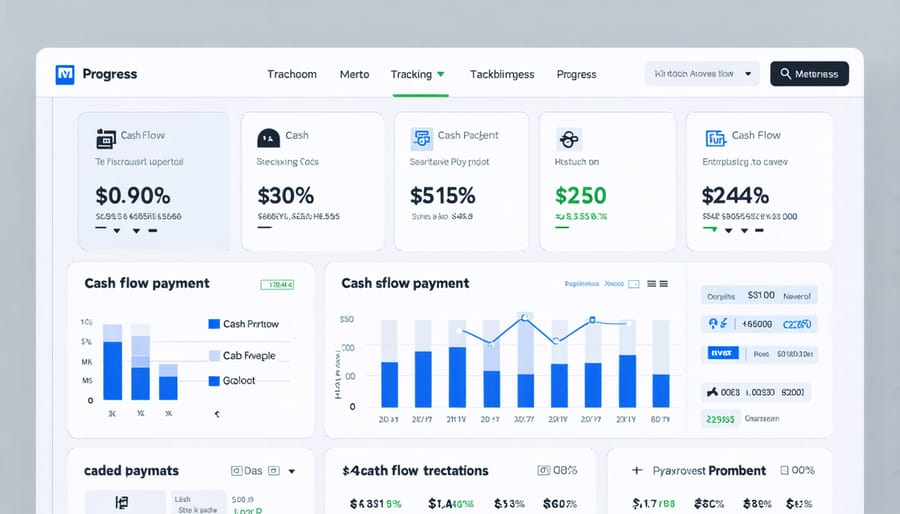Financial mismanagement derails 30% of construction projects before completion, with cost overruns averaging 28% above initial budgets. Effective financial management stands as the cornerstone of successful construction project delivery, demanding precision in budgeting, robust risk assessment, and strategic cash flow optimization. Modern construction financial management integrates advanced cost modeling software, real-time progress tracking, and predictive analytics to maintain project viability from groundbreaking to handover.
The evolving complexity of construction projects, coupled with market volatility and supply chain disruptions, necessitates a sophisticated approach to financial oversight. Project managers must simultaneously control costs, maintain adequate cash reserves, and ensure profitability while navigating material price fluctuations, labor constraints, and regulatory requirements. This dynamic environment demands a comprehensive financial management framework that aligns project objectives with fiscal reality.
Success in construction financial management requires mastery of three critical elements: precise cost estimation and budgeting, proactive risk management, and strategic cash flow planning. Industry leaders increasingly leverage integrated project management platforms, blockchain technology for payment transparency, and artificial intelligence for cost forecasting to maintain competitive advantages while ensuring project financial health.
Risk-Based Financial Planning in Construction

Identifying Financial Risk Factors
Construction projects face numerous financial risks that can significantly impact their success and profitability. Understanding and identifying these risk factors early is crucial for implementing effective financial risk management strategies.
Market volatility ranks among the primary risk factors, affecting material costs, labor rates, and equipment expenses. Price fluctuations can drastically alter initial budget projections, particularly in long-term projects. Supply chain disruptions and unexpected material shortages can lead to costly delays and budget overruns.
Payment-related risks pose another significant challenge, including delayed payments from clients, payment defaults, or disputes over change orders. These issues can severely impact cash flow and project continuity. Additionally, contractual risks, such as unclear terms, scope creep, or inadequate risk allocation between parties, can result in financial disputes and legal complications.
External factors like economic downturns, regulatory changes, or environmental requirements can introduce unexpected costs. Weather-related delays, site conditions, or unforeseen technical challenges may require additional resources and extend project timelines.
Performance bonds and insurance-related risks must also be considered, as inadequate coverage can expose companies to significant financial liability. Furthermore, currency fluctuations in international projects and interest rate changes can affect financing costs and overall project economics.
Understanding these risk factors enables project managers to develop robust mitigation strategies and maintain better financial control throughout the project lifecycle.
Creating Risk-Adjusted Budgets
Creating risk-adjusted budgets in construction projects requires a systematic approach that incorporates potential uncertainties and their financial implications. The process begins with identifying key risk factors, including material price fluctuations, labor availability, weather conditions, and regulatory changes. These risks are then quantified using historical data, expert judgment, and probabilistic analysis.
A recommended practice is to implement a three-point estimation method, considering best-case, most likely, and worst-case scenarios for each major cost component. This approach helps establish realistic contingency reserves that protect against unexpected cost overruns while maintaining project feasibility.
Risk-adjusted budgets should include both known risks (contingency reserves) and unknown risks (management reserves). Typically, contingency reserves range from 5-15% of the base cost, depending on project complexity and risk profile. Management reserves, allocated for unforeseen circumstances, usually comprise an additional 3-7%.
Modern risk-adjusted budgeting also incorporates sensitivity analysis tools to understand how various risk factors impact the overall budget. Project managers can use Monte Carlo simulations to model multiple scenarios and determine appropriate budget cushions. This data-driven approach enables more accurate cost predictions and helps stakeholders make informed decisions about risk allocation.
Key components of a risk-adjusted budget include:
– Base cost estimates
– Identified risk costs
– Contingency allowances
– Escalation provisions
– Management reserves
– Risk response costs
Regular review and adjustment of these budgets ensure they remain relevant throughout the project lifecycle.
Cash Flow Management Strategies
Progress Payment Management
Progress payment management is crucial for maintaining healthy cash flow throughout construction projects. Effective management requires a structured approach to payment scheduling, documentation, and verification processes. Construction professionals should establish clear payment milestones tied to specific project deliverables and completion percentages.
The foundation of successful progress payment management lies in detailed contract documentation that outlines payment terms, schedules, and conditions. This should include specific requirements for payment applications, supporting documentation, and verification procedures. Implementing a standardized payment application process helps ensure consistency and reduces delays in payment processing.
To maintain positive cash flow, project managers should:
– Review and approve payment applications promptly
– Maintain accurate documentation of work completed
– Implement robust change order management systems
– Monitor retention amounts carefully
– Track payment schedules against project timelines
Regular site inspections and progress documentation are essential for verifying completed work before approving payments. Using digital tools for progress tracking and documentation can streamline this process, making it more efficient and transparent. These tools can help generate automated reports, store photos and documentation, and facilitate communication between stakeholders.
It’s equally important to manage subcontractor payments effectively, as delays can impact project progress and relationships. Establishing clear payment schedules with subcontractors and ensuring prompt processing of their invoices helps maintain project momentum and prevents potential disputes.
Project managers should also implement early warning systems to identify potential payment issues before they become critical. This includes monitoring key financial indicators, tracking payment histories, and maintaining open communication channels with all stakeholders. Regular financial reviews and forecasting help ensure adequate cash reserves are maintained throughout the project lifecycle.

Working Capital Optimization
Working capital optimization is crucial for successful construction project execution, requiring careful management of assets and liabilities throughout the project lifecycle. When managing construction financing, maintaining optimal working capital levels ensures smooth operations while maximizing resource efficiency.
Key strategies for working capital optimization include negotiating favorable payment terms with suppliers, implementing efficient inventory management systems, and establishing robust accounts receivable processes. Construction firms should aim to reduce the cash conversion cycle by accelerating collections while strategically timing payments to vendors.
Effective inventory management plays a vital role in working capital optimization. Just-in-time delivery systems can minimize storage costs and reduce tied-up capital in excess materials. Additionally, implementing digital inventory tracking systems helps prevent overstock situations and ensures materials are available when needed.
Project managers should regularly monitor working capital ratios and adjust strategies accordingly. Key metrics include the current ratio, quick ratio, and working capital turnover ratio. These indicators help identify potential cash flow issues before they impact project progress.
Advanced financial modeling tools can help forecast working capital requirements across different project phases. This enables proactive decision-making regarding funding needs and helps maintain optimal liquidity levels throughout the construction timeline.
To enhance working capital efficiency, consider:
– Establishing early payment discounts with suppliers
– Implementing progress billing systems
– Utilizing supply chain financing options
– Maintaining strong relationships with financial institutions
– Developing contingency plans for unexpected working capital needs
Regular review and adjustment of working capital strategies ensure construction projects maintain financial stability while maximizing operational efficiency.
Cost Control Systems

Real-Time Cost Tracking
In today’s digital construction landscape, real-time cost tracking has become an indispensable component of effective construction cost planning. Advanced project management software platforms now enable contractors and project managers to monitor expenses as they occur, providing unprecedented visibility into financial performance.
Cloud-based solutions integrate with procurement systems, time-tracking tools, and accounting software to capture and analyze costs instantly. These platforms can track labor hours, material usage, equipment rentals, and subcontractor payments in real-time, allowing project managers to identify cost overruns before they become significant issues.
Mobile applications have revolutionized field data collection, enabling supervisors to input labor hours, material deliveries, and equipment usage directly from the job site. This immediate data capture eliminates delays in cost reporting and reduces the risk of errors associated with manual data entry.
Modern cost tracking systems also incorporate automated alerts and reporting features. When costs approach or exceed predetermined thresholds, stakeholders receive immediate notifications, enabling swift corrective action. Dashboard visualizations provide clear, actionable insights into cost trends, budget variances, and project financial health.
Integration with Building Information Modeling (BIM) systems further enhances cost tracking capabilities by linking actual expenses to specific building components and work packages. This connection allows for more accurate cost allocation and improved forecasting of future expenses, making it easier to maintain budget compliance throughout the project lifecycle.
Variance Analysis and Response
Effective variance analysis in construction projects requires a systematic approach to identifying, measuring, and responding to cost deviations from the original budget. The process begins with establishing baseline costs and regularly comparing actual expenditures against planned costs across all project components.
Project managers should implement a three-tier variance analysis system: routine monitoring (weekly), detailed analysis (monthly), and comprehensive review (quarterly). This structured approach enables early detection of cost overruns and allows for timely corrective actions.
When variances are identified, they should be categorized by their root causes: material price fluctuations, labor productivity issues, scope changes, or external factors. Each variance must be quantified and assessed for its impact on the overall project budget. A variance threshold of ±5% typically triggers a formal investigation and response plan.
Response strategies should be proportional to the variance magnitude and nature. Minor variances might require simple adjustments to work schedules or procurement timing, while significant deviations may necessitate major interventions such as re-negotiating contracts or redesigning project elements.
Documentation is crucial throughout the variance analysis process. Maintain detailed records of identified variances, their causes, implemented solutions, and outcomes. This information becomes valuable for future project planning and helps prevent similar issues from recurring.
Regular stakeholder communication about variance findings and response measures ensures transparency and maintains project team alignment. Consider implementing earned value management (EVM) techniques to enhance variance detection and response effectiveness.
Financial Risk Transfer Mechanisms
Insurance and Bonds
Insurance and bonding requirements are critical components of construction project financial management, serving as essential risk mitigation tools. Construction projects typically require several types of insurance coverage, including Builder’s Risk Insurance, which protects against property damage during construction, and Commercial General Liability (CGL) insurance, covering third-party claims for bodily injury or property damage.
Professional liability insurance is crucial for design professionals and contractors, protecting against claims arising from errors or omissions in professional services. Workers’ compensation insurance is mandatory in most jurisdictions, covering employee injuries and related medical expenses.
Bonding requirements typically include bid bonds, performance bonds, and payment bonds. Bid bonds guarantee that contractors will honor their bids and enter into contracts if selected. Performance bonds ensure project completion according to specifications, while payment bonds guarantee that subcontractors and suppliers will be paid.
The cost of insurance and bonds should be carefully factored into project budgets, typically ranging from 1-5% of the total contract value. Contractors should maintain detailed documentation of coverage and regularly review policy terms to ensure adequate protection. Risk managers should also consider umbrella policies for additional coverage beyond standard policy limits.
Working with experienced insurance brokers and surety agents who understand construction risks is essential for obtaining appropriate coverage at competitive rates. Regular assessment of insurance needs throughout the project lifecycle helps maintain adequate protection while controlling costs.
Contractual Risk Allocation
Effective contractual risk allocation is fundamental to successful construction project financial management. By strategically structuring contract terms, project stakeholders can establish clear responsibilities and protect their financial interests. Key risk mitigation techniques through contracts include precise scope definition, fair payment terms, and well-defined change order procedures.
Indemnification clauses, insurance requirements, and performance bonds form the primary risk transfer mechanisms in construction contracts. These provisions should be carefully crafted to ensure equitable risk distribution among parties based on their ability to control and manage specific risks. Force majeure clauses deserve particular attention, especially given recent global events that have highlighted their importance in protecting parties from unforeseen circumstances.
Contract language should explicitly address potential schedule delays, cost escalations, and material availability issues. Including provisions for alternative dispute resolution methods can help avoid costly litigation while maintaining project momentum. Performance metrics and milestone-based payment structures can incentivize timely completion while protecting the owner’s financial interests.
Modern construction contracts increasingly incorporate provisions for digital documentation, Building Information Modeling (BIM) protocols, and cybersecurity requirements. These elements help manage technological risks while facilitating better project coordination and financial tracking. Regular contract review and updates ensure alignment with evolving industry standards and risk management best practices.

Technology Integration in Financial Management
Financial Management Software
Modern construction projects rely heavily on specialized financial management software to streamline operations and maintain precise control over budgets. These construction finance technology solutions integrate multiple financial functions, from cost tracking and budgeting to procurement and payroll management.
Leading software platforms offer real-time monitoring of project expenses, automated invoice processing, and customizable reporting features. Key capabilities typically include change order management, subcontractor payment tracking, and integration with accounting systems. These tools enable project managers to maintain detailed cost histories, forecast cash flow requirements, and generate accurate financial projections.
Cloud-based solutions have become increasingly popular, offering accessibility across multiple devices and locations while facilitating collaboration between team members. Advanced features such as AI-powered cost estimation and predictive analytics help identify potential budget overruns before they occur. Many platforms also include document management capabilities, ensuring all financial records, contracts, and compliance documentation are properly organized and easily retrievable.
Data Analytics for Financial Decision-Making
Data analytics has revolutionized financial decision-making in construction project management by enabling more accurate forecasting, real-time monitoring, and evidence-based strategic planning. Modern analytics platforms can process vast amounts of historical project data, current market conditions, and performance metrics to generate actionable insights for better financial outcomes.
Key applications include predictive cost modeling, which uses machine learning algorithms to forecast potential cost overruns and identify risk factors before they impact the project budget. By analyzing patterns from past projects, these systems can help managers make proactive decisions about resource allocation and cost control measures.
Performance dashboards provide real-time visibility into key financial metrics, including cash flow, expense tracking, and budget variance analysis. This immediate access to critical data enables project managers to make timely adjustments and maintain better financial control throughout the project lifecycle.
Advanced analytics tools also facilitate better vendor management by analyzing supplier performance, payment histories, and market rates to optimize procurement decisions and negotiate more favorable terms. Integration with project management software ensures that financial data analysis directly influences operational decisions, creating a more efficient and profitable construction process.
Effective financial management remains the cornerstone of successful construction projects in an increasingly complex industry landscape. As we’ve explored throughout this article, the integration of robust cost control measures, strategic risk management, and modern technological solutions creates a solid foundation for project financial success.
Key strategies that have proven instrumental include implementing comprehensive budgeting systems, maintaining detailed cost tracking mechanisms, and utilizing advanced project management software. The adoption of real-time reporting tools and predictive analytics has revolutionized how construction firms approach financial decision-making and risk mitigation.
Looking ahead, the construction industry faces both challenges and opportunities. The rise of sustainable construction practices, increasing material costs, and labor market fluctuations will continue to impact project finances. However, emerging technologies such as artificial intelligence, blockchain, and automated cost estimation tools promise to enhance financial management capabilities significantly.
Success in future construction project financial management will depend on organizations’ ability to adapt to these changes while maintaining fundamental financial principles. Companies that invest in employee training, embrace technological innovation, and develop robust risk management frameworks will be better positioned to navigate future challenges.
As the industry evolves, maintaining a balanced approach between traditional financial management practices and innovative solutions will be crucial for achieving project success and maintaining competitive advantage in the construction sector.

